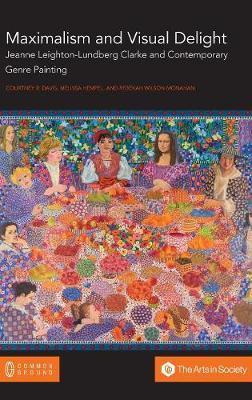Maximalism and Visual Delight: Jeanne Leighton-Lundberg Clarke and Contemporary Genre Painting

Maximalism and Visual Delight: Jeanne Leighton-Lundberg Clarke and Contemporary Genre Painting
Bright, bold, and bursting with color-drenched patterns, the paintings of the postmodernist American artist Jeanne Leighton-Lundberg Clarke (1925-2014) shimmer like the stained-glass windows of an abstract cathedral. For decades, her "Favorite Ladies" paintings have delighted viewers with their almost whimsical appropriation of famous women from the history of art, borrowing from the canvases of such artists as Édouard Manet, Pablo Picasso, and Andy Warhol. Stylistically paralleling the post-modernist movement of Pattern & Decoration, Clarke explored gender, familial relationships, and religious symbolism from sometimes unexpected and even contradictory perspectives; she explored femininity and female roles while resisting the label of feminist. Clarke, however, embraced the stylistic descriptor of maximalism. For decades, critics and historians have employed the term maximalism both to describe artworks and designs that embrace decorative overload and visual excess as well as to define trends that counter the reductive qualities of the minimalist aesthetic. When Clarke identified herself as a maximalist in 1980, she was the first known artist in contemporary history to use the term to denote a formal stylistic approach, rather than simply an adjective. Following in her pioneering footsteps, this book is the first to explore the contributions of Clarke as well as her role in the development of Maximalism. The authors take the reader on a visual journey, exploring the modernist roots of Clarke and her gendered approach to contemporary genre painting and culminating in a survey of the early twenty-first century fascination with Maximalism.
PRP: 403.00 Lei
Acesta este Prețul Recomandat de Producător. Prețul de vânzare al produsului este afișat mai jos.
362.70Lei
362.70Lei
403.00 LeiLivrare in 2-4 saptamani
Descrierea produsului
Bright, bold, and bursting with color-drenched patterns, the paintings of the postmodernist American artist Jeanne Leighton-Lundberg Clarke (1925-2014) shimmer like the stained-glass windows of an abstract cathedral. For decades, her "Favorite Ladies" paintings have delighted viewers with their almost whimsical appropriation of famous women from the history of art, borrowing from the canvases of such artists as Édouard Manet, Pablo Picasso, and Andy Warhol. Stylistically paralleling the post-modernist movement of Pattern & Decoration, Clarke explored gender, familial relationships, and religious symbolism from sometimes unexpected and even contradictory perspectives; she explored femininity and female roles while resisting the label of feminist. Clarke, however, embraced the stylistic descriptor of maximalism. For decades, critics and historians have employed the term maximalism both to describe artworks and designs that embrace decorative overload and visual excess as well as to define trends that counter the reductive qualities of the minimalist aesthetic. When Clarke identified herself as a maximalist in 1980, she was the first known artist in contemporary history to use the term to denote a formal stylistic approach, rather than simply an adjective. Following in her pioneering footsteps, this book is the first to explore the contributions of Clarke as well as her role in the development of Maximalism. The authors take the reader on a visual journey, exploring the modernist roots of Clarke and her gendered approach to contemporary genre painting and culminating in a survey of the early twenty-first century fascination with Maximalism.
Detaliile produsului









